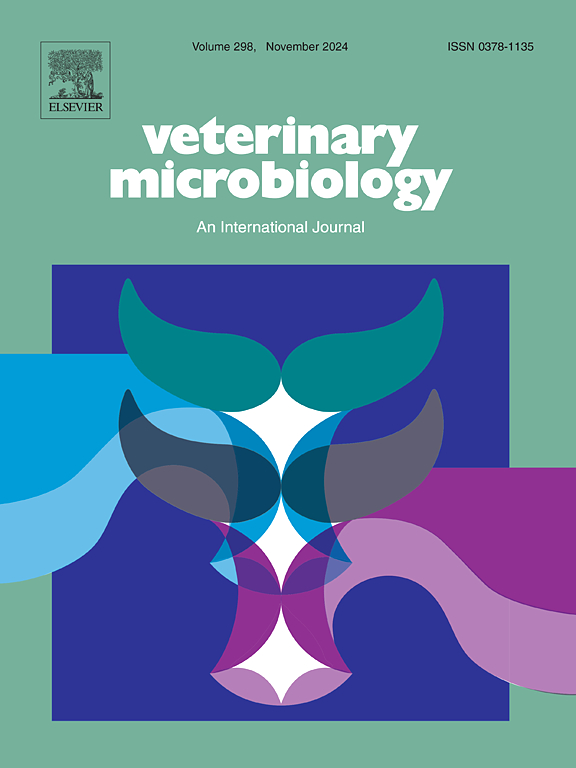巴伐利亚野猪布鲁氏菌病监测:与世界动物卫生组织列出的血清学检测相比,评估一种新型基于rLPS/ slps的ELISA
IF 2.7
2区 农林科学
Q3 MICROBIOLOGY
引用次数: 0
摘要
布鲁氏菌病是由布鲁氏菌属引起的一种全球重要的人畜共患疾病,其野生动物宿主,如野猪,对无布鲁氏菌病的牲畜种群和公共卫生构成潜在威胁。尽管德国已经消灭了家畜中的布鲁氏菌病,但这种疾病仍然存在于野生动物中。可靠和特定的诊断工具对于有效监测至关重要。材料与方法本研究对2023/2024年德国巴伐利亚州捕获的野猪149份血清样本进行了四项血清学检测:1。2.玫瑰孟加拉试验(RBT);2 .传统的基于slps的酶联免疫吸附试验(BMS);同时使用sLPS和rLPS抗原的新型双孔ELISA (BSI)。补体固定试验(CFT)为金标准。与CFT相比,计算了所有检测方法的敏感性、特异性和准确性。结果149份样本中,9份呈CFT阳性,血清阳性率为6.0 %[3.1 %,11.2 %]。BMS-ELISA的灵敏度最高(100 %),但特异性中等(85.0 %),而BSI ELISA通过联合检测sLPS和rLPS抗体,虽然灵敏度较低(66.7 %),但特异性(94.3 %)和准确性(92.6 %)有所提高。RBT表现最差,敏感性为55.6% %,特异性为92.7 %。研究结果证实,布鲁氏菌病在巴伐利亚野猪中仍然是地方性的。虽然BSI ELISA因其高特异性而显示出希望,但其较低的灵敏度限制了其作为独立诊断的实用性。基于slps的检测中的交叉反应强调了结合抗原对提高检测可靠性的重要性。与以前的研究相比,不同的血清患病率强调了野生动物种群感染的动态性质。结论双步骤诊断方法——利用敏感的ELISA进行筛选,然后用CFT进行确认——仍然是野生动物监测最有效的策略。在临床或资源有限的情况下,BSI ELISA可作为一种可行的替代方法。持续监测对于减轻野生水库造成的人畜共患病风险至关重要。本文章由计算机程序翻译,如有差异,请以英文原文为准。
Brucellosis surveillance in Bavarian wild boar: Evaluation of a novel rLPS/sLPS-based ELISA compared to OIE-listed serological tests
Introduction
Brucellosis is a globally significant zoonotic disease, caused by Brucella spp., with wildlife reservoirs such as wild boars posing a potential threat to brucellosis-free livestock populations and public health. Despite eradication of brucellosis in domestic animals in Germany, the disease persists in wildlife. Reliable and specific diagnostic tools are essential for effective surveillance.
Material and methods
In this study, 149 serum samples from wild boars hunted during the 2023/2024 season in Bavaria (Germany) were analyzed using four serological tests: 1.the rose bengal test (RBT), 2. a conventional sLPS-based ELISA (BMS),3. a novel biwell ELISA (BSI) using both sLPS and rLPS antigens and 4. the complement fixation test (CFT) as gold standard. Sensitivity, specificity, and accuracy of all assays were calculated in comparison to the CFT.
Results
Of the 149 samples analyzed, 9 tested positive by CFT, resulting in a seroprevalence of 6.0 % [3.1 %, 11.2 %]in the sampled wild boar population. The BMS-ELISA demonstrated the highest sensitivity (100 %) but moderate specificity (85.0 %), whereas the BSI ELISA showed improved specificity (94.3 %) and accuracy (92.6 %) through combined detection of antibodies against sLPS and rLPS, albeit with lower sensitivity (66.7 %). The RBT performed least favorably with a sensitivity of 55.6 % and specificity of 92.7 %.
Discussion
The findings confirm that brucellosis remains endemic among wild boars in Bavaria. While the BSI ELISA shows promise due to its high specificity, its lower sensitivity limits its utility as a stand-alone diagnostic. Cross-reactions in sLPS-based assays highlight the importance of combining antigens for improved test reliability. The varying seroprevalence compared to previous studies underscores the dynamic nature of infection in wildlife populations.
Conclusion
A dual-step diagnostic approach – utilizing a sensitive ELISA for screening followed by CFT for confirmation – remains the most effective strategy for wildlife surveillance. The BSI ELISA may serve as a viable alternative in clinical or resource-limited settings. Continued monitoring is crucial to mitigate the zoonotic risk posed by wildlife reservoirs.
求助全文
通过发布文献求助,成功后即可免费获取论文全文。
去求助
来源期刊

Veterinary microbiology
农林科学-兽医学
CiteScore
5.90
自引率
6.10%
发文量
221
审稿时长
52 days
期刊介绍:
Veterinary Microbiology is concerned with microbial (bacterial, fungal, viral) diseases of domesticated vertebrate animals (livestock, companion animals, fur-bearing animals, game, poultry, fish) that supply food, other useful products or companionship. In addition, Microbial diseases of wild animals living in captivity, or as members of the feral fauna will also be considered if the infections are of interest because of their interrelation with humans (zoonoses) and/or domestic animals. Studies of antimicrobial resistance are also included, provided that the results represent a substantial advance in knowledge. Authors are strongly encouraged to read - prior to submission - the Editorials (''Scope or cope'' and ''Scope or cope II'') published previously in the journal. The Editors reserve the right to suggest submission to another journal for those papers which they feel would be more appropriate for consideration by that journal.
Original research papers of high quality and novelty on aspects of control, host response, molecular biology, pathogenesis, prevention, and treatment of microbial diseases of animals are published. Papers dealing primarily with immunology, epidemiology, molecular biology and antiviral or microbial agents will only be considered if they demonstrate a clear impact on a disease. Papers focusing solely on diagnostic techniques (such as another PCR protocol or ELISA) will not be published - focus should be on a microorganism and not on a particular technique. Papers only reporting microbial sequences, transcriptomics data, or proteomics data will not be considered unless the results represent a substantial advance in knowledge.
Drug trial papers will be considered if they have general application or significance. Papers on the identification of microorganisms will also be considered, but detailed taxonomic studies do not fall within the scope of the journal. Case reports will not be published, unless they have general application or contain novel aspects. Papers of geographically limited interest, which repeat what had been established elsewhere will not be considered. The readership of the journal is global.
 求助内容:
求助内容: 应助结果提醒方式:
应助结果提醒方式:


